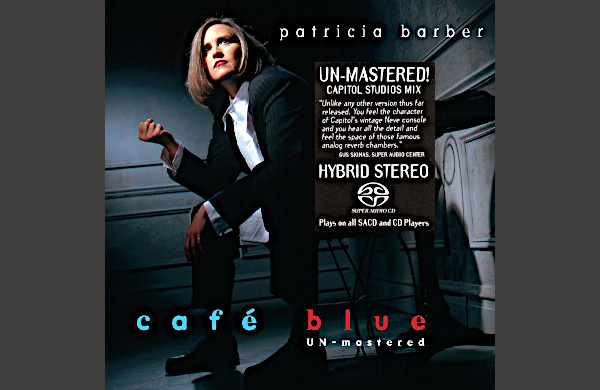Patricia BARBER: Café Blue Un-Mastered
Label: Premonition Records SACD, 90760-5
Produced by: Patricia Barber
Un-Mastered by: Gus Skinas, Super Audio Center, DR14
Recorded by: Jim Anderson, Chicago Recording Company, 1994
Patricia Barber and her Café Blue is a staple of audiophile listening. I have to admit that I have never understood why it had become such a cult for there were and still are many other female-fronted jazz trios, quartets and quintets that exhibit much better artistic and sonic qualities.

Actually, the better one´s equipment gets the easier the downsides of how the album´s tracks are recorded, mixed and mastered can be heard. Notably, the echo chambers that were used to enhance the spacious feel during tracking the record are the reason why the album sounds so terrific and revealing on bad systems and so embarrassing and unnatural on the good ones. The Echo Chambers were constructed below the ground level of Capitol Studios to add ambience to recordings. Each chamber has a unique design and its own unique character (an imprint on the sound in audiophile terms) which can provide up to 5 seconds of uncolored reverb. In case of the Café Blue the reverb was inconsistently misused to end up with the ambient field that differs instrument by instrument.
For example, the Barber´s voice lacks any natural depth and have a weird spatial relationship to the piano that she plays. Arnopol´s double-bass, the real star of the album, sounds wonderfully tight as if recorded in a somewhat dry studio, whereas the snapping fingers in Ode to Billy Joe are super-close miked with long cathedral-like decays, while Barber´s vocal is somewhere in the middle, as if she sat in a smaller live chapel. The track definitely sounds very alive and attractive at first listen, yet it fails to deliver the illusion of real musicians recorded in a real acoustic space. When the noise threshold of an audiophile system drops, like I have recently experienced when reviewing Stromtank-powered Mola Mola electronics, these things become more easily discernible to the point that they start to distract from the music. The album then comes out ´forced´ from speakers with inner relationships of music impaired.
Released by Premonition Records in 1994 the album is available in 21 reprints and remasters on CD and vinyl according to discogs.com. However, there are only four versions cherished by audiophiles and considered to have premium sound quality: First Impression Music licensed release FIM CD010, Mobile Fidelity Sound Lab UDSACD2002 and MFSL 3-45002 vinyl, Analogue Productions remaster CPRM 90760 SA, and Premonition Record´s own 24K Gold Collector´s Edition HDCD 90760-G.
Now the Café Blue is also available in its Un-Mastered version. Gus Skinas – who is responsible for the un-mastering job – appreciated the clarity and dynamics of digital masters yet he felt that the commercial mastering used in all previous releases left the potential of the recording unexploited. Hence the ´un-mastering´ that strives to restore as much of the raw unprocessed sound of Café Blue as possible.
I compared the CD and SACD layer of Café Blue Un-Mastered hybrid version to the 24K Gold Collector´s Edition remaster and MFSL SACD remaster and I can tell you right away that the new un-master is sonically a completely different league. Even the CD layer of the Un-Mastered is superior to the SACD layer of the MFSL remaster, there is so much more ease in the music, much more contrast between the quiet and the loud. It is as if 5 thousand dynamic shades of the re-master have grown into 5 million shades of the un-master. The sibilants of the un-mastered version are less forced and more natural, as is Arnopol´s double bass. The latter sounds more powerful and definitely more dynamic, though it also sounds a bit less incisive and ´tight´. Personally I find it more like ´the real thing´ but you may have a different preference. Ode to Billy Joe obviously keeps the signature sounds of the analog echo chambers, yet there is much more cohesiveness and integrity to how to music communicates. The Café Blue was not re-recorded so the Un-Mastered is not the best exercise in natural imaging of a jazz ensemble, but it is a champion of beauty of the tone, transient fidelity, and incredible dynamics.
The SACD layer of the Un-Mastered adds even better sense of space and size, I can hear deeper into individual instruments´ reverbs and these reverbs stay distinct and more airy even during the busier parts. The SACD layer also trumps the CD layer with how resolving it is in the natural development and bloom of tones. This can be easily heard on the timbral percussive carnival of Inch Worm, or piano and cymbal subtleties of Nardis.
The dynamic gradations of the SACD layer are stunning and become a hard-way learning for vinyl lovers (sorry!) who can only dream of such dynamic finesse, and also for those who doubt that dynamic compression kills music. Though the CD layer of the hybrid is exquisite, going back to it from the Super Audio leaves you with more closed-in sound and certain stridency that makes the piano sound more like a mechanical toy.
Not only is the Un-Mastered superior to any previously released version of Café Blue, it is one of the finest sounding recordings that has been ever pressed on a disc. Bravo!



